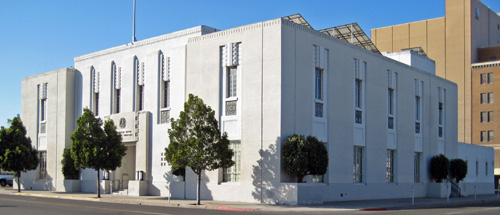Fred L. Swartz (1885-1968)
Fred L. Swartz was born in Girard, Kansas, on June 9, 1885. He graduated in 1903 from Fresno High School, where he was a star football player. After a short period working as a logger at Shaver Lake, Swartz took a job with an architectural office in San Francisco. In 1907 he entered a two-year program at the University of Pennsylvania, where he studied under the legendary Paul Cret.
In 1909 young Swartz returned to Fresno to work for his father, A. C. Swartz (1846-1919), who had been practicing architecture in Fresno since 1890. As junior partner in the firms of Swartz & Son, Swartz, Hotchkin & Swartz, and finally Swartz & Swartz, Fred Swartz established a solid reputation as an architect of schools, commercial blocks, and homes. After his father's death in 1919, Swartz formed a partnership with C. J. Ryland (1892- 1980), who had studied architecture at the University of Toulouse, France. Swartz & Ryland built a large practice that included projects throughout the San Joaquin Valley, the East Bay and the Monterey Bay Area. Among their projects were a Fresno home for C. H. Ingram (1923), the Oakland Union Bus Depot (1926), the Bank of Carmel (1929) and the Fresno State College Library (1933).
 In the
mid-1930s Swartz and Ryland dissolved their partnership, after which he
associated with Allied Architects of Fresno. Swartz
briefly joined W. D. Coates in 1937 to design the
Fresno Scottish Rite Temple (on right). During World War II, Swartz worked as a
civilian architect for the Navy and designed a SeaBees base near Pleasanton,
California. After the war Swartz formed the firm of Swartz & Hyberg with
William G. Hyberg. They designed the Fresno County Library (1958) and C. L.
McLane High School (1959). Swartz retired from practice in 1965. Fred L. Swartz
was regarded as the dean of Fresno architects when he died in Fresno on October
13, 1968.
In the
mid-1930s Swartz and Ryland dissolved their partnership, after which he
associated with Allied Architects of Fresno. Swartz
briefly joined W. D. Coates in 1937 to design the
Fresno Scottish Rite Temple (on right). During World War II, Swartz worked as a
civilian architect for the Navy and designed a SeaBees base near Pleasanton,
California. After the war Swartz formed the firm of Swartz & Hyberg with
William G. Hyberg. They designed the Fresno County Library (1958) and C. L.
McLane High School (1959). Swartz retired from practice in 1965. Fred L. Swartz
was regarded as the dean of Fresno architects when he died in Fresno on October
13, 1968.
©1996 John Edward Powell. All rights reserved.